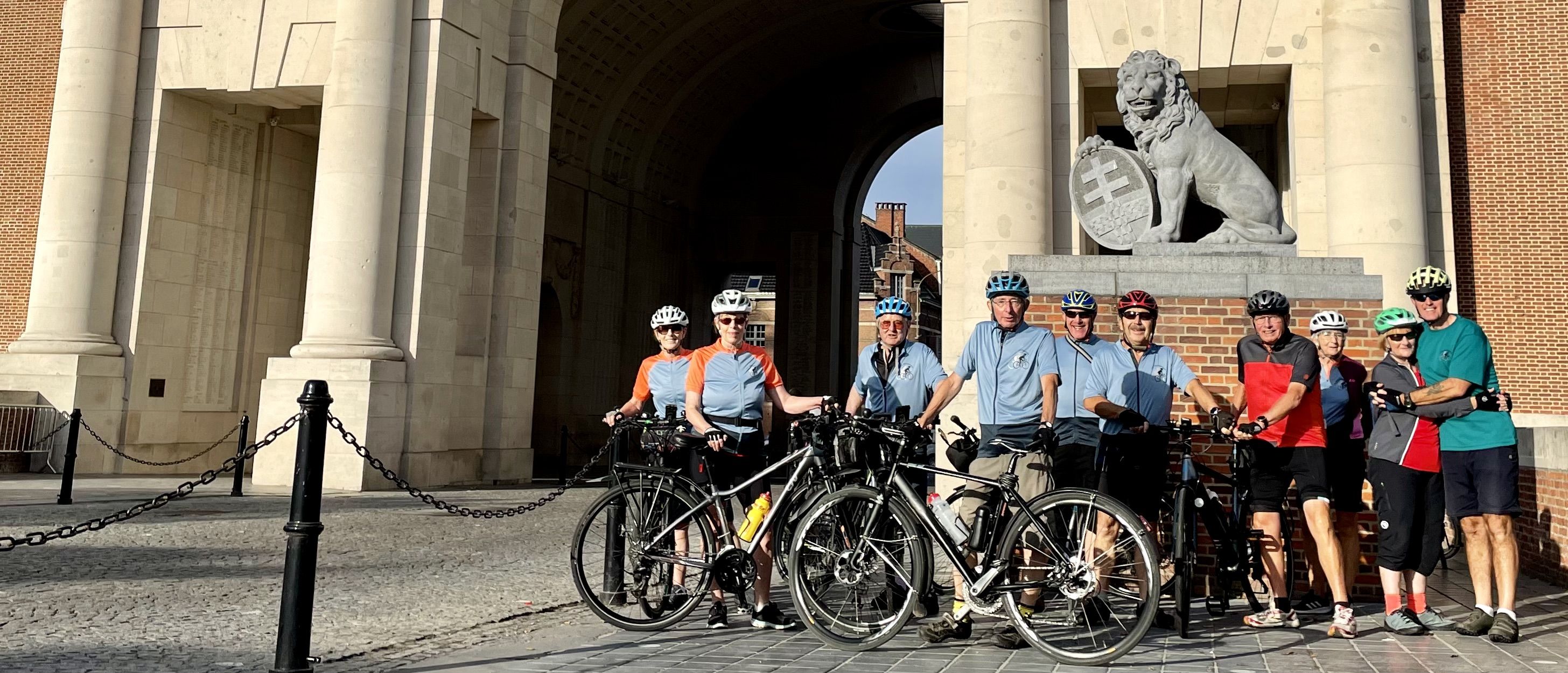This tour was different, in that it was centre based and we were riding without carrying our luggage on the bikes, so more of a cycling holiday. After the long hot dry summer, the weather broke here just before we were due to leave on the trip, although it turned out to be warm in Belgium and France and we largely avoided rain during the rides.
Day 1
On Monday 5th September we travelled to Ypres in four cars. The original plan, was to drive to Bruges for a sightseeing tour around the city on our bikes that Mick had devised before moving on to our overnight stop at Ypres. However, the timing of the various channel crossings meant that only one group could fit this in. So it was Mick, Mark and Alistair who took the Eurotunnel Shuttle and parked at the station in Bruges, unloaded the bikes and set off on the tour around the sights. The route followed the path along the Gent-Brugge Canal with its many windmills and stopped to watch a large dredger passing under the lifting bridge at Gentpoort. We left the main canal side path at Dampoort and headed along the road beside a smaller canal towards the main squares and surrounding streets packed with tourists. Just past the Torture Museum, Mick spotted a sandwich bar where we stopped on the canal wall opposite whilst our paninis and coffees were brought to us. As time was now getting on, we decided to head back to the car by the almost direct route. Once the bikes were loaded, we headed off for Ypres, just in time for the madness of the rush hour traffic on the Lille Peripherique and were last to arrive. Bruges
Bruges
David, SueC and Len took a later P&O ferry to Calais and drove to Ypres stopping on the way for lunch in St Omer. Rod, SueP and Vanessa took the ferry to Dunkirk but were delayed by traffic so opted to drive directly to Ypres as did Keith and Janice who took a later ferry.
In the evening, we dodged the downpour while enjoying a beer before the rain stopped just in time for the Last Post ceremony at the Menin Gate.
The Menin Gate Memorial to the Missing is dedicated to the British and Commonwealth soldiers who were killed in the Ypres Salient of World War I and whose graves are unknown. The memorial is located at the eastern exit of the town and marks the starting point for one of the main roads out of the town that led Allied soldiers to the front line. Its large Hall of Memory contains names on stone panels of 54,395 Commonwealth soldiers who died in the Salient but whose bodies have never been identified or found. On completion of the memorial, it was discovered to be too small to contain all the names as originally planned. An arbitrary cut-off point of 15 August 1917 was chosen and the names of 34,984 UK missing after this date were inscribed on the Tyne Cot Memorial to the Missing instead.
David had booked us a table afterwards at a nearby restaurant where we enjoyed a meal before returning to our hotels.
Day 2
On Tuesday after breakfast, we met up for the start of the Ypres salient ride most wearing cycling kit with our group logos – you can spot the odd one out in the photo beside the Menin Gate. The route followed marked cycle paths clockwise around the north, east and south of Ypres. The surface of the mainly tarmac cycle paths put UK roads to shame. The first section followed the canal northwards to Boezinge where we passed the Essex Road Cemetery without even noticing it. It was in Essex Farm Cemetery that Lieutenant-Colonel John McCrae of the Canadian Army Medical Corps wrote the poem ' In Flanders Fields' in May 1915.
The route then turned eastwards towards Langemark where we stopped at the Soldatenfriedhof, a German war cemetery where 38330 soldiers are buried including 24917 in a mass grave. During the First Battle of Ypres (1914) in World War I, inexperienced German infantry suffered severe casualties when they made a futile frontal attack on allied positions near Langemark and were checked by experienced French infantry and British riflemen. Contrary to popular myth, only fifteen percent of the German soldiers involved in the Battle of Langemark were schoolboys and students. Legend has it that the German infantry sang the first stanza of what later (1919) became their national anthem "Deutschland, Deutschland über alles", as they charged.
We continued on the cycle path and into Poelkapelle where there was a memorial to a WW1 French fighter ace, Georges Guynemer, with 50 kills to his credit who was shot down over Poelkapelle. Adjacent there was the Ypres Salient Tank Memorial. We then headed south on the cycle path beside the Brugesweg to the St Julien Canadian Memorial, known as The Brooding Soldier. The memorial commemorates the Canadian First Division's participation in the Second Battle of Ypres of World War I which included fighting in the face of the first poison gas attacks along the Western Front. the Canadians held the line and prevented a German breakthrough until they were relieved by reinforcements on the 24 April.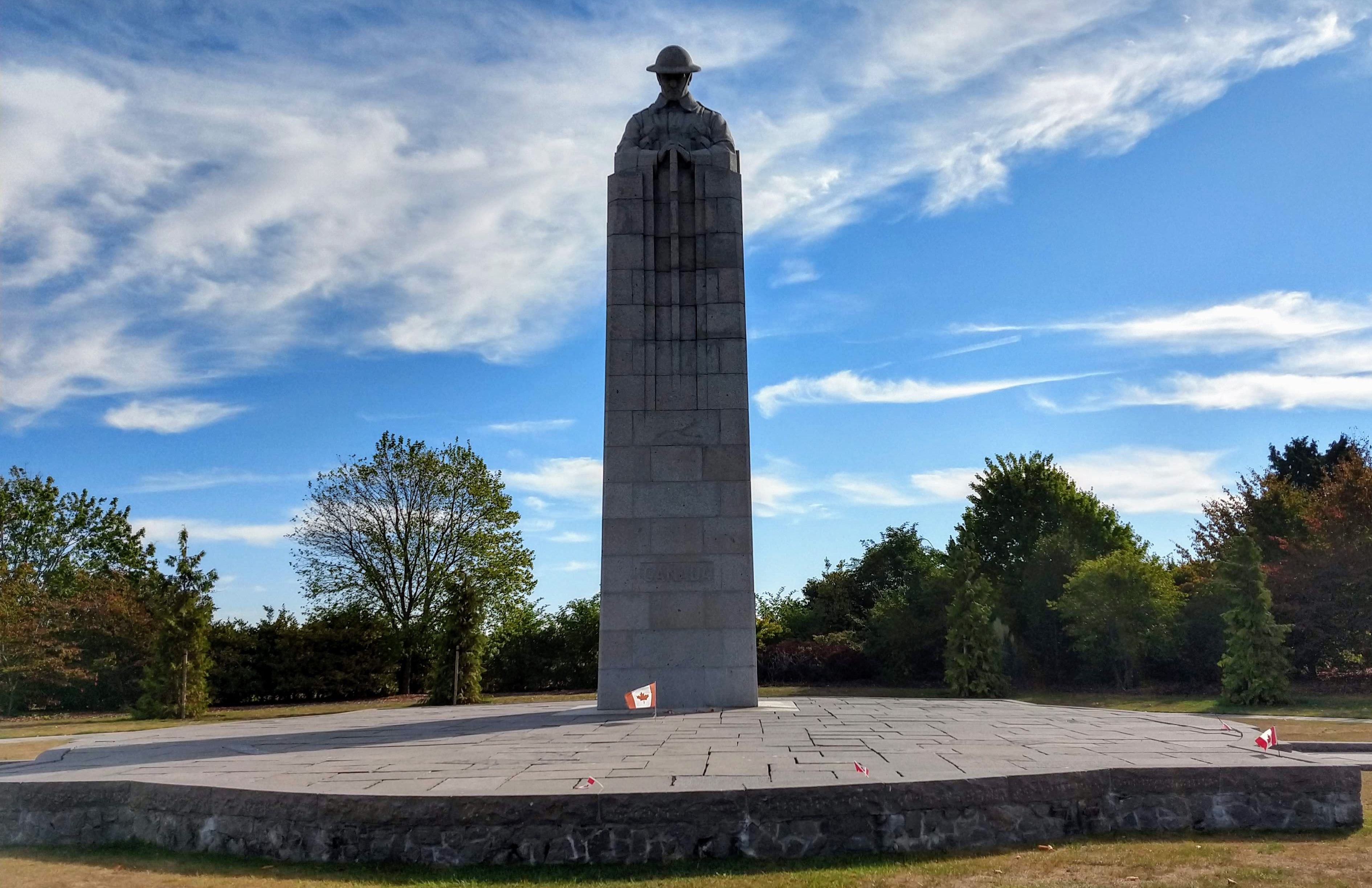 Canadian Memorial - Brooding Soldier
Canadian Memorial - Brooding Soldier
In the 48 crucial hours that they held the line, 6,035 Canadians - or one man in every three who went into battle - became casualties; of that number, approximately 2,000 (or one man in every nine) were killed.
On a building opposite there was a commemorative plaque to Edward Bellew VC. It was during the Second Battle of Ypres that a mass attack on the Canadian line developed where the Canadians were suffering heavy casualties. The advance of the enemy was temporarily stayed by Lieutenant Bellew, the battalion machine-gun officer, who had two guns in action on high ground when the enemy's attack broke in full force. The reinforcements sent forward having been destroyed, and with the enemy less than 100 yards away and no further assistance in sight, Lieutenant Bellew and a Sergeant Peerless decided to fight it out. The sergeant was killed and Lieutenant Bellew wounded, nevertheless, he maintained his fire until his ammunition failed, when he seized a rifle, smashed his machine-gun and, fighting to the last, was taken prisoner.
Turning east we passed two memorials on the way. At the second one a MGB stopped and told us a bit about the location which was on an almost unnoticeable rise in the ground that was the firing line between the opposing armies. Further on at a crossroads we stopped at the New Zealand Memorial before carrying on to the Tyne Cot Cemetery where for the first time there were many other visitors. 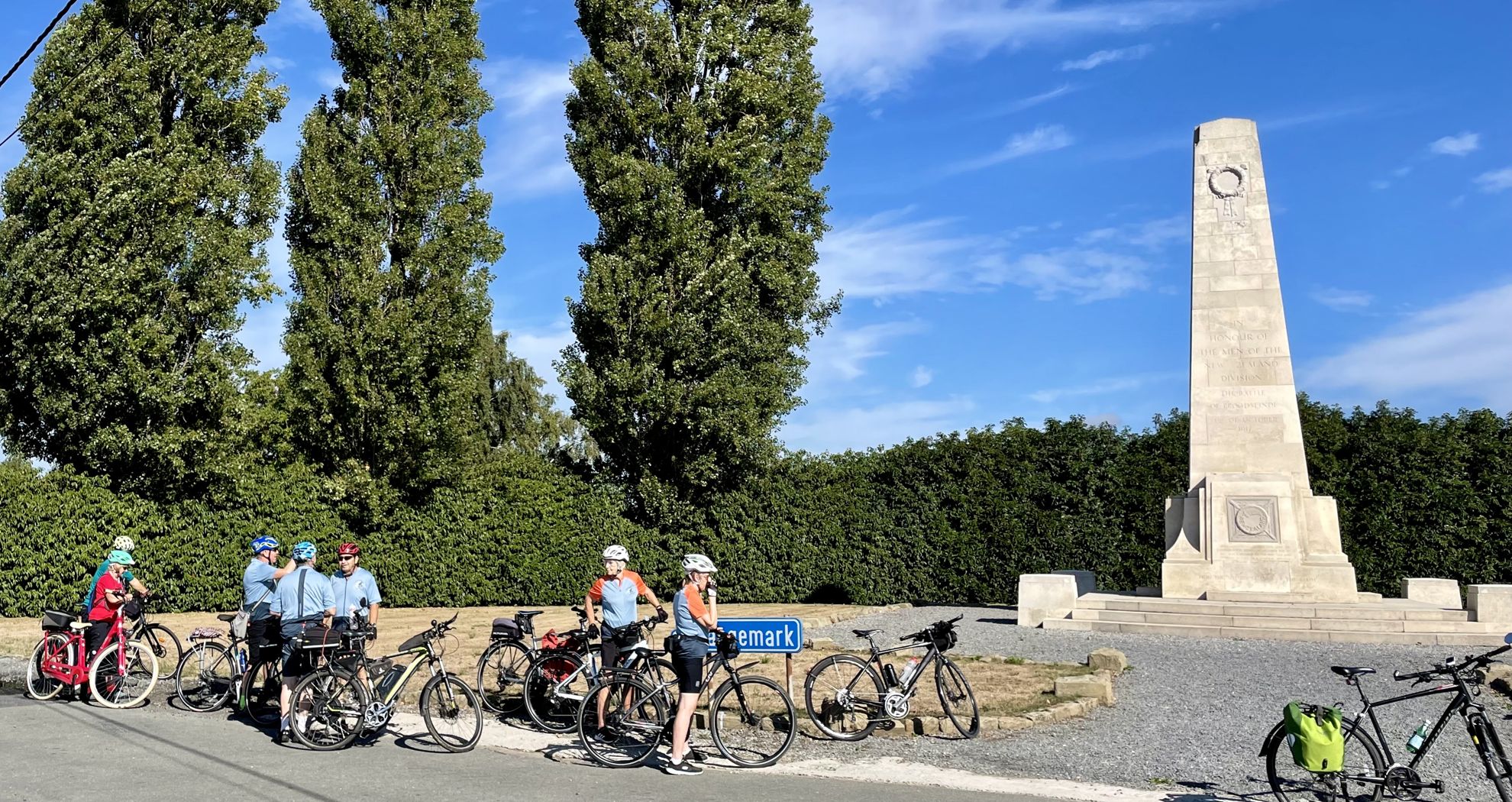 New Zealand MemorialTyne Cot is a Commonwealth War Graves Commission (CWGC) burial ground for the dead of the First World War in the Ypres Salient on the Western Front. It is the largest cemetery for Commonwealth forces in the world, for any war. There are 11,961 Commonwealth servicemen of the First World War buried or commemorated in Tyne Cot Cemetery, 8,373 of these are unidentified. The TYNE COT MEMORIAL bears the names of almost 35,000 officers and men whose graves are not known. The scale of the dead at this site gave us pause for thought.
New Zealand MemorialTyne Cot is a Commonwealth War Graves Commission (CWGC) burial ground for the dead of the First World War in the Ypres Salient on the Western Front. It is the largest cemetery for Commonwealth forces in the world, for any war. There are 11,961 Commonwealth servicemen of the First World War buried or commemorated in Tyne Cot Cemetery, 8,373 of these are unidentified. The TYNE COT MEMORIAL bears the names of almost 35,000 officers and men whose graves are not known. The scale of the dead at this site gave us pause for thought. Tyne Cot
Tyne Cot
At this stage, thoughts turned towards where we could stop for lunch and so missed out the loop to the Passchendaele Canadian Memorial and continued into Zonnebeke and the Passchendaele Museum where we had lunch at the restaurant in the Memorial Park. There was not enough time to explore the museum, the park or the preserved trenches so we carried on to the next point at Polygon Wood and visited the Buttes New Cemetery. At Passchendaele Memorial Park
At Passchendaele Memorial Park
Shortly after this we came to a new recently completed memorial that will be officially inaugurated on 25 September 2022. The Brothers In Arms Memorial Park commemorates all pairs of brothers and sisters who fought together in de First World War and of whom at least 1 was killed during the war. The bronze statue depicts two Australian soldiers with Jim Hunter cradling his elder brother John who was killed at Polygon Wood and buried there by his brother.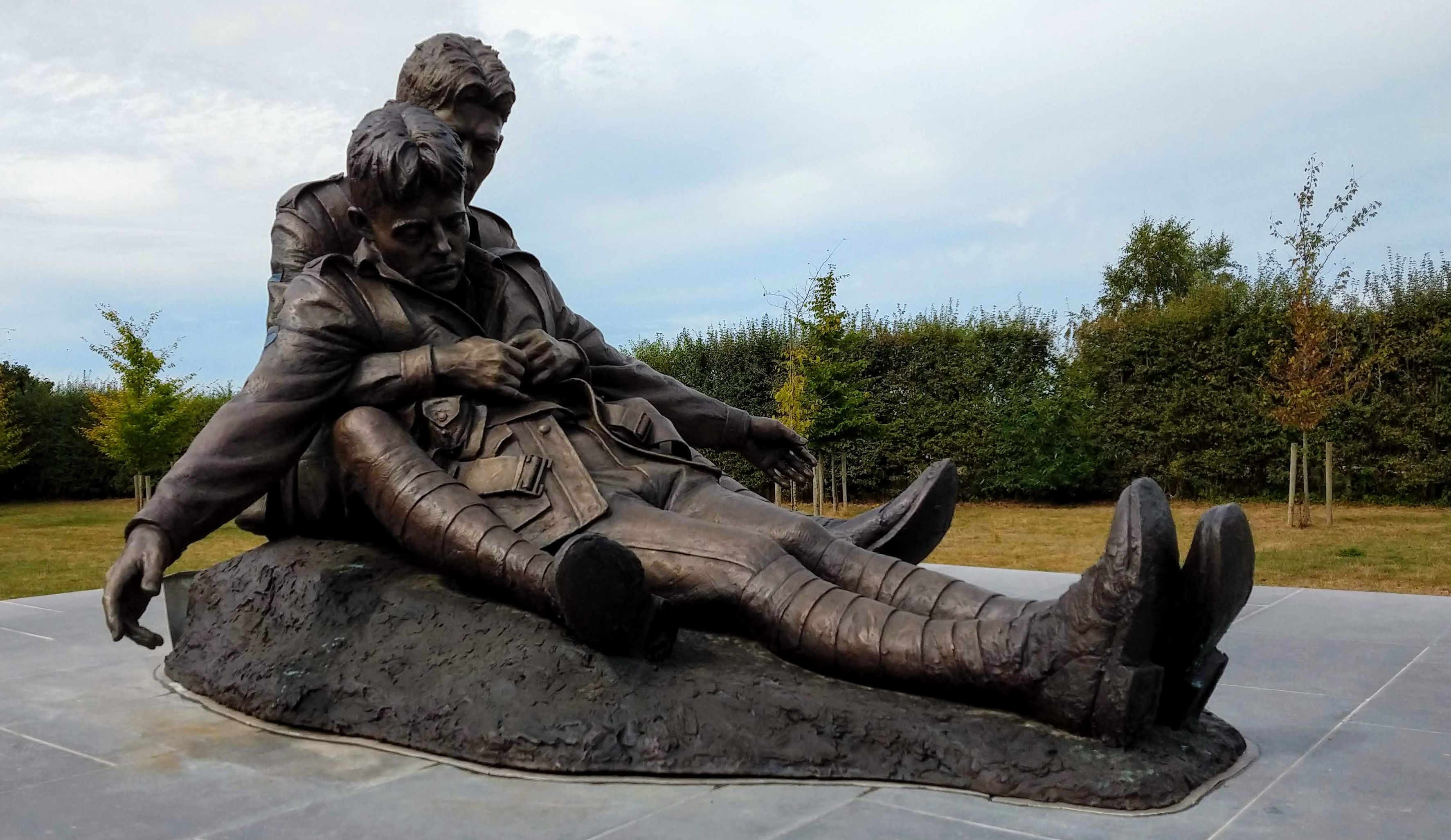 Brothers in Arms Memorial
Brothers in Arms Memorial
Further along the route, the road had been dug up for new drainage, so it was a bumpy ride for a bit. Turning the corner, the road was completely closed so we diverted to pick up the cycle path beside the N8 passing the Hooge Crater Cemetery and Museum before turning off towards Sanctuary Wood Cemetery. By the time we got there, Len’s bolts holding his e-bike gearbox had loosened so much they were rubbing on the chainring. Fortunately, I had a T2.5 Torx key and was able to retighten them. At this point about half the group preferred to take a more direct route back to Ypres as time was getting on and we still needed to load the bikes on the cars and drive to our next overnight stop in Arras. Whilst they headed back down the hill to the cycle path beside the N8 and the straight road back to Ypres, Mick, Mark, Keith, Janice and I continued on the planned route.
Shortly after Sanctuary Wood was the Hill 62 Museum that looked worth a visit, with the intact section of British trench system. But with time pressing, we carried on and rode through the grounds of the Hill 62 Canadian Memorial that commemorates the actions of the Canadian Corps in defending the southern stretches of the Ypres Salient between April and August 1916 including actions in battle at the St Eloi Craters, Hill 62, Mount Sorrel and Sanctuary Wood.
Again we had to just look fleetingly at the Hill 60 preserved site and did not divert off to visit the Caterpillar mine crater. There was a nice downhill run until we turned off at some woods where we rode on very bumpy a cobbled path for nearly a mile before the path improved. From there it was smooth roads and cycle paths back to our cars in Ypres. For the whole ride it was 33 miles and only 223m ascent.
Once the bikes were loaded, we headed for Arras, not a pleasant journey in rush hour traffic on the Peripherique through Lille and 1 hr 45 minutes later we reached our destination and parked in the main square beside our hotel. Whilst the early arrivals were enjoying a beer we sorted out the bikes, showered and unpacked before joining them in a restaurant close to the hotel for our nice evening meal during which there was a thunderstorm with heavy rain.
Day 3
After breakfast we loaded the bikes onto the cars and drove to Albert for the ride around the Somme battlefields, arriving in time for the 10:00 start. From the main square beside the Mairie we rode the short distance to the Basilique Notre Dame de Brebeiers with its impressive tower. We passed the Somme 1916 Underground Museum and out into the countryside on quiet roads beside the river to Aveluy where we climbed out of the valley and stopped at the Martinsart Cemetery.
Martinsart was close to the Allied front line until September 1916, and again from March to August 1918. There are now 488 First World War servicemen buried or commemorated in the cemetery. The cemetery is unusual in that the graves are marked by stones made from red Corsehill or Locharbriggs sandstone, rather than the more usual Portland stone.
From there the road ran down to the valley bottom before turning uphill again to the Newfoundland Memorial Park. We were welcomed into the memorial park by the Canadian staff. The Beaumont-Hamel Newfoundland Memorial site is in an area containing numerous cemeteries and memorials related to the Battle of the Somme. The site is one of the few places on the former Western Front where a visitor can see the trench lines and no-man's land of the First World War and the related terrain in a preserved natural state. It is the largest site dedicated to the memory of the Newfoundland Regiment, the largest battalion memorial on the Western Front, and the largest area of the Somme battlefield that has been preserved. We walked around the impressive memorial with its bronze caribou sitting on top of a mound with views over the whole site.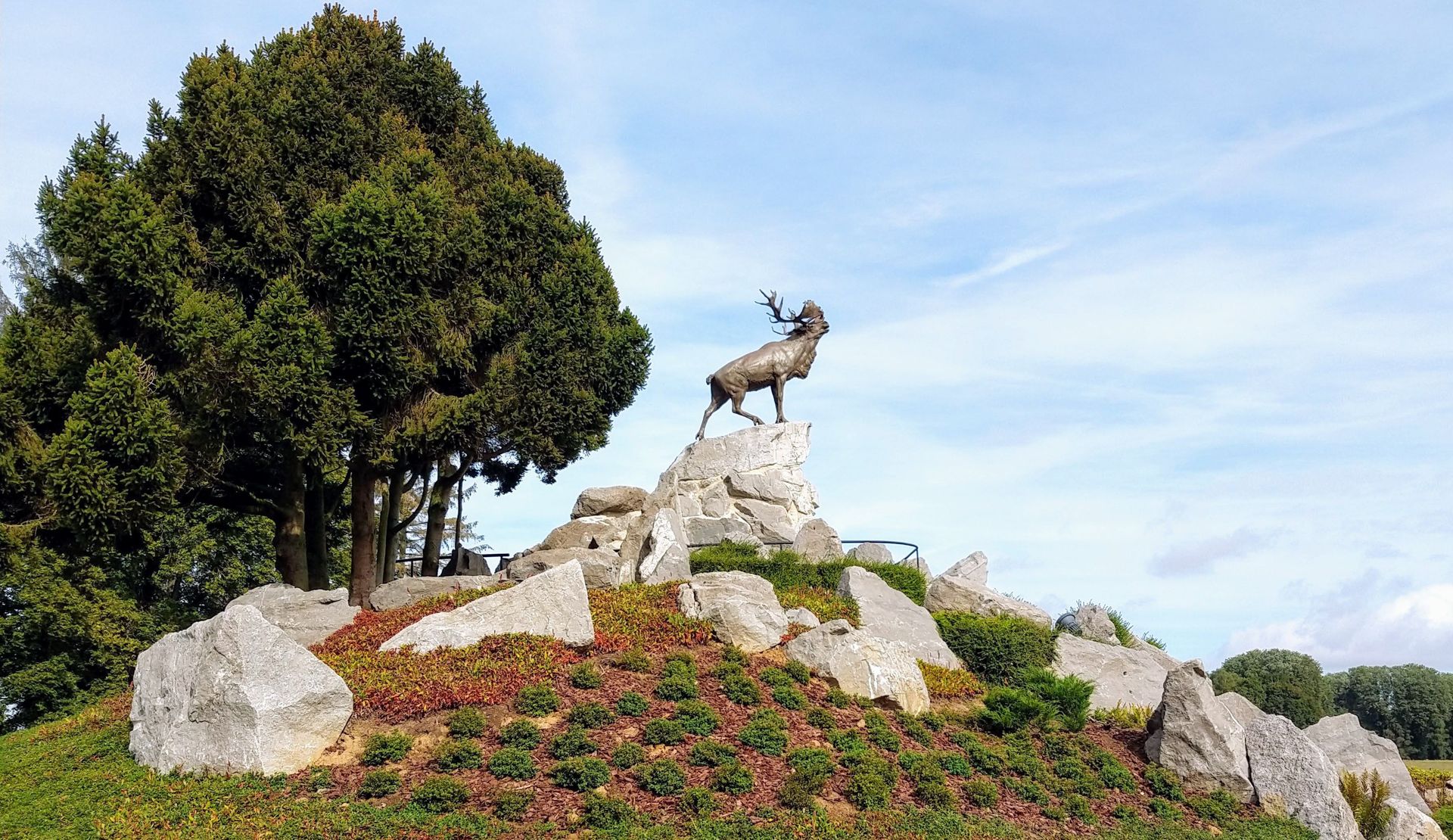 Newfoundland Memorial
Newfoundland Memorial
At this point Rod and SueP turned back to ride directly to the next main site at Thiepval whilst we looped north to visit the Serre Road Cemeteries before heading down through Beaumont Hamel to the river again. The road then climbed up the valley side passing Connaught Cemetery and the Ulster Memorial Tower that was one of the first memorials to be erected on the Western Front and commemorates the men of the 36th (Ulster) Division and all those from Ulster who served in the First World War. The memorial was officially opened on 19 November 1921 and is a very close copy of Helen's Tower which stands in the grounds of the Clandeboye Estate, near Bangor, County Down, Northern Ireland. Many of the men of the Ulster Division trained in the estate before moving to England and then France early in 1916.
It was only a short distance to the Thiepval Memorial where we stopped for lunch at the café there and were joined by Rod and SueP. After lunch, we visited the huge memorial where there is inscribed on the supporting piers the names of the 72,337 missing British and South African servicemen who died in the Battles of the Somme of the First World War between 1915 and 1918, with no known grave. It was designed by Sir Edwin Lutyens, and Thiepval has been described as "the greatest executed British work of monumental architecture of the twentieth century" Thiepval
Thiepval
We continued to Poziers stopping at the Australian Memorial, a tribute to the 1st Australian Division who took part in the capture of the village with the 48th British Division. The path to the memorial is the first trench in the German scheme defended by what was once the Gibraltar Blockhouse (one of two observation sites in the area), the foundations of which are still visible.
We then passed through Martinpuich and on to the London Cemetery, one of five in the immediate vicinity of Longueval which together contain more than 15,000 graves, is the third largest cemetery on the Somme with 3,877 First World War burials, 3,114 of them unidentified. In the middle of Longueval there is a Piper’s Memorial at the scene of very heavy fighting by the 9th (Scottish) Division during the Battle of the Somme in July 1916. The plaques around the base of the statue show the regiments which lost a piper.
Shortly after we came to Delville Wood Cemetery and South African National Memorial. The memorial at is a national memorial dedicated to all South Africans who served in all theatres of war. The memorial is located at the end of a central avenue leading into Delville Wood from the main entrance. A more recent impressive museum sits behind the memorial.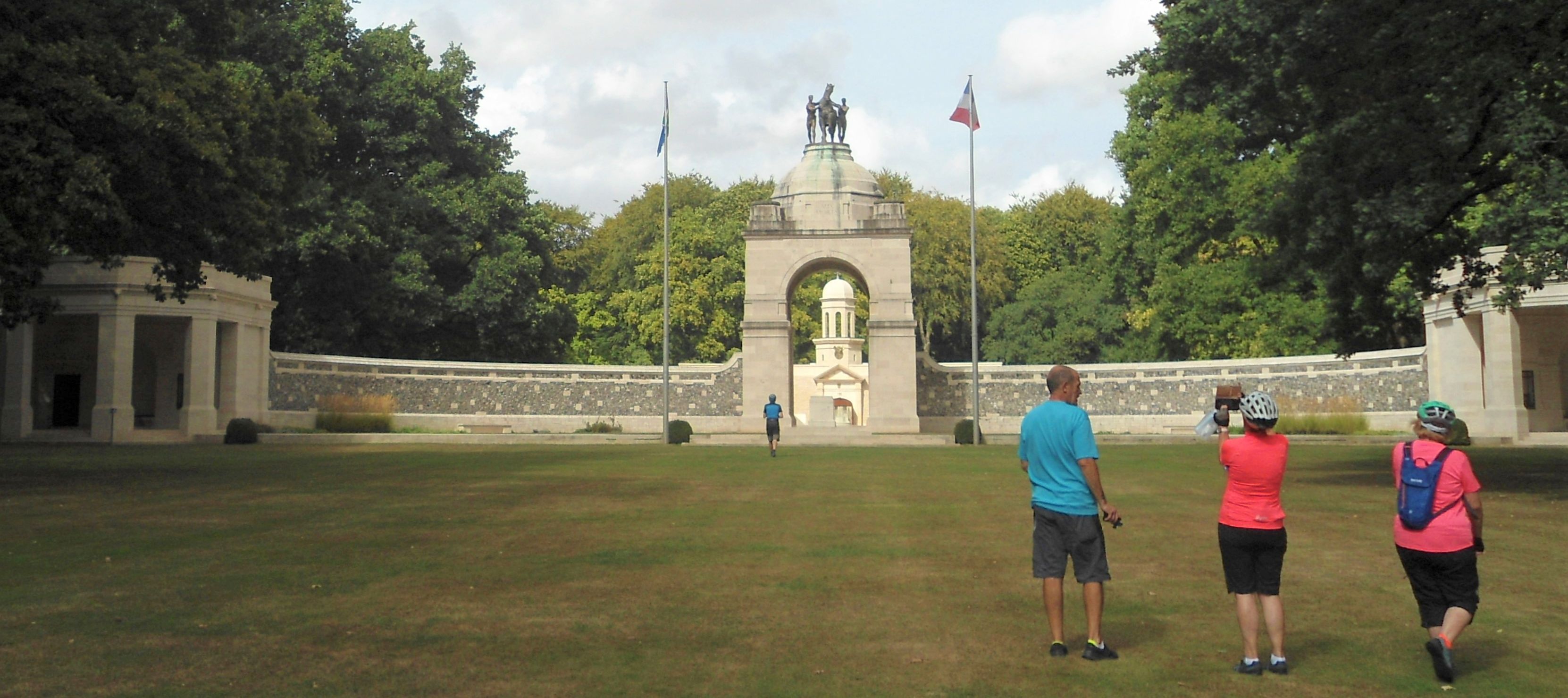
It is the only memorial dedicated to the participation of the South African Forces on the 1914-1918 Western Front. 229,000 officers and men served with the South African Forces in the Great War. This place is where the battalions of the South African Brigade came under withering German artillery fire in their attempt to capture and then defend the wood in mid July 1916. This attack was against the German Second Position and the South African Brigade was serving with the British 9th Division in this action. Both the wood and the South African battalions were almost completely destroyed. The South African Brigade had gone into battle here on 15th July 1915 with a strength of 121 officers and 3,032 other ranks. At roll call on 21st July they numbered only 29 officers and 751 other ranks.
At this point Rod and SueP opted to take a slightly shorter route back to Albert whilst the remainder us carried on. Just after Montauban de Picardie, we could see the rain was not far away and stopped to put jackets on and sheltered under some trees. After a short pause we decided to ride on in the rain and took the road to the Flatiron Copse Cemetery that changed to a rough track that was slippery in the wet as we passed the Welsh Division Memorial that took the form of a red dragon. By the time we got to Mametz the rain had ceased.
We stopped at Fricourt to visit the German Cemetery that is the resting place for 17,027 German First World War soldiers. They died on the Somme battlefields over the four years of the Great War, from late September 1914, when the German Second Army established a defensive front line in this sector, to the spring and summer Battles of the Somme in 1918. From the beginning of the British and French Allied Somme offensive of 1st July 1916 to the close of the battle in mid-November 1916 approximately 10,000 German soldiers lost their lives on the Somme battlefields. A further 6,000 German soldiers were killed during the large-scale German offensive, called the “Kaiserschlacht” by the German Army, from 21st March 1918 and in the battles which followed it up to October 1918.
The route then took a loop to visit the Lochnagar Mine Crater, unfortunately most of this up to the site was on a now muddy track. The Lochnagar mine crater is the largest man-made mine crater created in the First World War on the Western Front. It was laid by the British Army's 179th Tunnelling Company Royal Engineers underneath a German strongpoint called “Schwaben Höhe”. The mine was exploded two minutes before 07.30 am Zero Hour at the launch of the British offensive against the German lines on the morning of 1st July 1916. The full route was 39 miles with 630m ascent.
From there it was an easy ride back to Albert and the cars. We stopped off at a Lidl to pick up some wine, crisps and nuts for a pre-dinner drink in our hotel courtyard [it had no bar or restaurant] before eating at the Bar a Viande across the street – not a place for vegetarians.
Day 4
After breakfast, we checked out and loaded the cars with luggage and bikes and set off for Necropole Nationale de Notre Dame de Lorette at the top of Mont Hernu at the start of the ride. It is a place of remembrance and contemplation but also the largest necropolis in France, it commemorates the battles that took place on this hill in 1915. Located in the municipality of Ablain-Saint-Nazaire, the site consists of a Neo-Byzantine basilica, a 52-metre-high lantern tower and a huge military cemetery, the largest in France, where 40,058 bodies have been laid to rest.
The ride started with a very steep descent to the village of Ablain Saint Nazaire then rose gently on quiet country roads to the tall transmitter masts on the top of the ridge where we picked up the EV5 cycle path with its smooth tarmac surface. We followed this all the way back to the foot of the hill at the start where we visited the Living Museum of 14-18 in an impressive black concrete and glass building. It was only supposed to be a quick in and out but the displays were so good, we were there for a little while – well worth visiting if you are over this way.
This delayed us somewhat before continuing on the EV5 to the outskirts of Lens where we turned back and climbed up to Vimy Ridge and its Memorial in a short rain shower.
The Canadian National Vimy Memorial is dedicated to the memory of Canadian Expeditionary Force members killed during the First World War. It also serves as the place of commemoration for Canadian soldiers of the First World War killed or presumed dead in France who have no known grave. The monument is the centrepiece of a 100-hectare (250-acre) preserved battlefield park that encompasses a portion of the ground over which the Canadian Corps made their assault during the initial Battle of Vimy Ridge offensive of the Battle of Arras.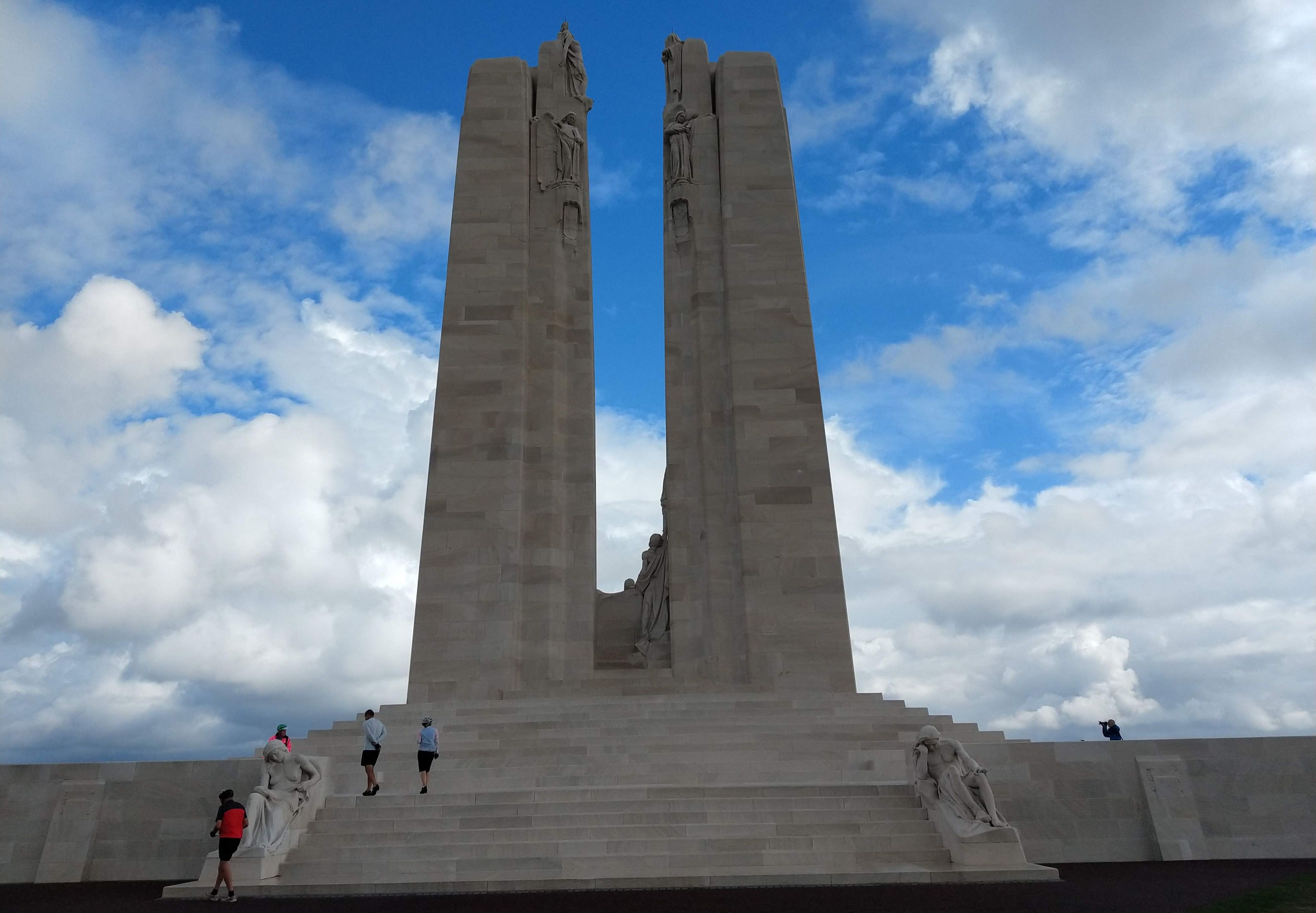 Vimy Ridge
Vimy Ridge
The Battle of Vimy Ridge was the first time all four divisions of the Canadian Expeditionary Force participated in a battle as a cohesive formation, and it became a Canadian national symbol of achievement and sacrifice.
We carried on to the Visitor Centre but were disappointed it did not have a café so opted to continue on and at Neuville St Vaast we found a Bar Tabac for coffee but no food. The route took us to the German War Cemetery where 44,888 German war dead of World War I rest in Neuville-St. Vaast. The complex is the largest German military cemetery of the First World War in France. From more than 110 communities in the Pas-de-Calais department, the German dead who had been temporarily buried in field graves or small war cemeteries were reburied. They died in the heavy fighting around Artois and around the Lorette heights from August 1914 to the end of 1915, around the Vimy heights in Easter 1917 and in the autumn of 1918, as well as during the trench warfare that lasted between the days of major fighting.
The next section was on the busier road to Arras for the short distance to Necropole Nationale de La Targette a French cemetery spread over an area of 4.45 ha. The necropolis contains the graves of 11,443 French soldiers of the First World War who died during the two battles of Artois, in May-June and during the autumn of 1915. It also contains the graves of 593 French soldiers who died during the Second World War. The three ossuaries also contain the graves of 3,212 unknown French soldiers and 185 identified French soldiers from the First World War. Next to it was the smaller British war cemetery. To avoid the main road, the route took some back roads that deteriorated into a rough track before joining the main road at the edge of Souchez. We opted to miss out the small diversion to the Cabaret Rouge cemetery and continued through the town to pick up the road that climbed back up the hill to Lorette where we had a look around the Memory Ring, a ring of remembrance erected In 2014 that is inscribed with the names of nearly 580,000 soldiers of all backgrounds who died on Nord-Pas-de-Calais soil between 1914 and 1918. This was a shorter ride at 29 miles with 530m ascent.
Once back at the cars, the bikes were loaded and we changed into civvies before visiting the adjacent restaurant for coffee and cake [meal service was finished] then headed on the long trip home via the various channel crossings.

